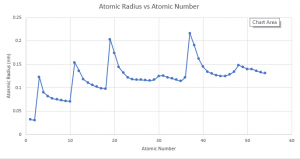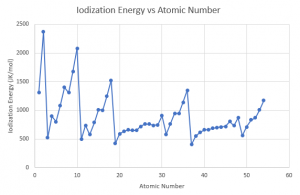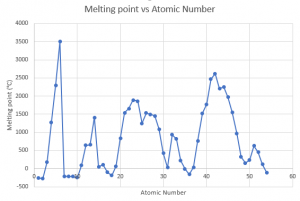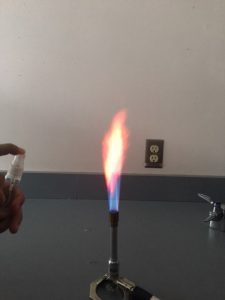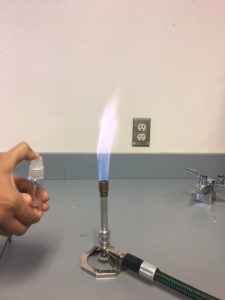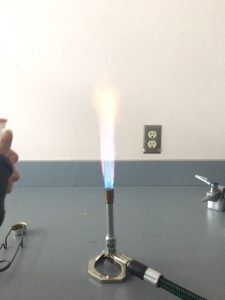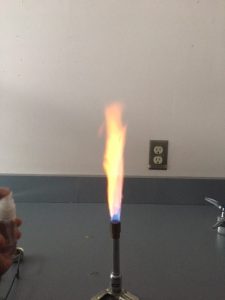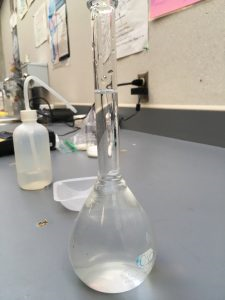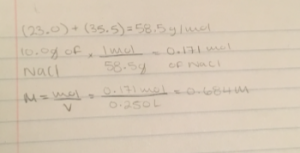Atomic radius versus atomic number
Which is the largest of the first 54 elements?
- Rubidium (0.216 nm)
Describe how the atomic radius varies within a period and within a family.
- The atomic radii decreases from left to right along each period and increases from top to bottom of the group.
Use your graph to predict the atomic radius of the following elements:
- (a) cesium ~ 0.252
- (b) tungsten ~ 0.142
- (c) thallium ~ 0.167
- (d) radon ~ 0.136
Which group of the main group elements contains the largest elements?
- The 1st group of main elements
Ionization energy versus atomic number
How would you explain ionization energy to your partner?
- Ionization energy is a quantity of energy and is the amount of energy needed to remove an electron. Usually, the closer the electrons are to the nucleus, the higher ionization energy it will have.
How does the ionization energy vary within a period and within a family?
- when you move to the right of a period the number of electrons increases and makes it easier for ionization. This ionization energy will decrease from the top to bottom of a family or group.
Which element on your graph has the strongest hold of its valence electrons?
- helium has the strongest hold of its valence electrons. This is because helium has a full valence electron shell. Helium is also furthest to the right and in the top row of elements meaning that it has a high ionization energy.
Write the electron configuration for chlorine.
- Cl -> 1s2 2s2 2p6 3s2 3p5
Which electron is lost when 1251 kJ/mol of energy are applied to a sample of chlorine atoms?
- When 1251 kJ/mol of energy is applied to a sample of chlorine, it will lose its valence electron.
Compare the ionization energies of metals to nonmetals.
- Nonmetals have high ionization energies because they usually will gain electrons to form negative ions and have strong attractions for their valance electrons Metals have low ionization energies because they take smaller amounts of energy to remove these electrons from the atom.
Melting point versus atomic number
Describe the trend of melting points within a period
- The melting points within a period will increase due to the strength between the metallic bonds. The number of electrons, that each atom can contribute to be shared among more than two atoms in a molecule, increases. Atoms will also get smaller and contain more protons as you move from left to right.
Which group of elements tends to have the highest melting points.
- Metals tend to have the highest melting points, the stronger that the bonds are, the more energy is need to break them to change the state of the element.
Tungsten is used in incandescent light bulbs because it has an extremely high melting point. Which element on your chart could be a reasonable replacement for tungsten? Why?
- Carbon is a reasonable replacement for tungsten because it has the highest melting point of all elements
Density versus atomic number
Describe how density varies within a period.
- The density increase as you move from left to right and from top to bottom. As you get to the gaseous the density will be much lower that those of the solids.
Compare the densities of the elements in the second period with the elements in the third period.
- The third period is denser than the second period because it is further away from the left side of the periodic table. When you move from left to right on the periodic table the density will increase in number.
Assume that the transition metals given in the table are representative of the other members of this group. How do the densities of the transition metals compare with those of the elements in the main group?
- Transition metals have the highest densities of any group on the periodic table, and their densities increase steadily and gradually compared to the elements in the main group which densities that aren’t as high.
Explain why aluminum and magnesium are more suitable than iron for use in some airplane parts.
- Since the material used in an aircraft need to be lightweight, aluminum and magnesium are the most suitable for being used for aircraft parts. The combination of the two elements makes the aircraft light and durable.
Electronegativity versus atomic number
Describe how electronegativity varies within a period.
- As you move from left to right across a period the electronegativity will increase.
Describe how electronegativity varies within a family.
- As you move from the top to bottom of a group or family the electronegativity of an element will decrease, this is because the increased number of energy levels puts the outer electrons further from the pull of the nucleus.
